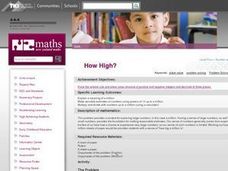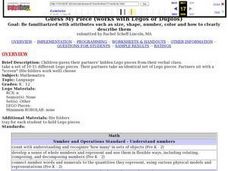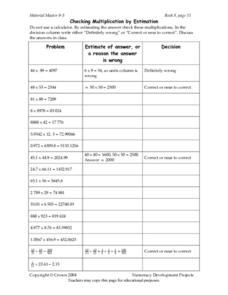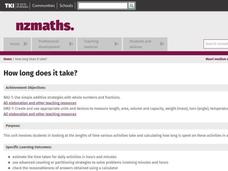Curated OER
Buying My First Car
Students pretend they are about to buy their first new car. They must do all the calculations necessary to estimate the cost of purchasing the car. They see that the math they learn in school really does have real-life applications.
Curated OER
Can You Guess
Students develop useful strategies for mental calculation when estimating possible addition solutions. They mentally perform calculations involving addition and subtraction. Students state the estimated sum or difference between numbers.
Curated OER
Art: It Takes a Village
Young scholars identify the different areas found in a Winter Games Village and different sports played in the Winter Games. This will be done through whole group brainstorming.
Curated OER
Everything Has Parts
Students investigate and explore common objects to discover and identify their parts. They also are encouraged to discuss the need for specific parts and what happens when a part is missing from the whole.
Curated OER
Time Problems
Students make sensible estimates and check for reasonable results. They also solve problems with positive and negative integers using practical activities or models as needed.
Curated OER
Even And Odd Results Maze
In this math worksheet, students examine the numbers in the maze and determine if they are even or odd. The sheet is a teacher's guide.
Fuel the Brain
Brain Boosters - Telling Time
Using images of two clocks, youngsters determine what number is missing from the clock and estimate what time it is.
Curated OER
Around and Across
Tenth graders investigate the circumference and diameter of a circle. In this geometry activity, 10th graders relate circumference to diameter. They create a scatter plot to estimate the value of pi.
Curated OER
Construct Figures to Find Specific Volume
Sixth graders use number cubes to explore volume of two-dimensional shapes. They roll a die and construct a shape using the numbers rolled as measurements of the sides. They estimate the volume of a given object, and then use the...
Curated OER
How High?
Fourth graders play an estimation game to guess how sheets of paper are in a pile and then guess who high a stack of one million would be. They work in small groups to explore ideas for working out how high the stack would be.
Curated OER
Waste Audit
Students engage in a lesson that is concerned with the concept of mental math. They perform calculations as following: recognizing a half, three quarters, and tenths. Students are also challenged to extend skills to making calculation...
Curated OER
Guess My Piece -working with Legos
Young scholars participate in guessing their partners' hidden Lego pieces from their verbal clues. They work in partners to accomplish their goals. They are meeting a variety of math standards by completing this activity.
Curated OER
TAAS Attack Daily Upkeep 2 4th Grade
In this elementary math worksheet, 4th graders practice solving problems for reviewing the concepts of number sentences, numeration, and geometry.
Curated OER
Graph and Compare the Adventure's Temperature Vs. Local Temperature
Students explore the concept graphing data. In this graphing data lesson, students use weather data from their local weather and some other city and graph them. Students plot the local weather vs. another city. Students record...
Indiana Science
How Many E’s?
Seventh graders explore random sampling by estimating the number of e's on the newspaper. They explain the possible error sources for this type of sampling, and compare the accuracy of sampling a small and large population. This is a...
Curated OER
Vegie Gardening
Students investigate the concept of Veggie Gardening and develop the plans for a successful yield of crops. They answer some practical questions and then apply the information to the horticulture garden. The project includes finding the...
Curated OER
Checking Multiplication By Estimation
In this checking multiplication by estimation worksheet, 8th graders answer twenty six problems by estimating the answer in the decision column and then discuss their answers in class.
Curated OER
A Billion Hungry People
Students discover the inequality of food distribution. In the hunger lesson, students discuss how some places and people do not get the food they need to survive. Students role play distributing pretend meals to people (of unequal...
Curated OER
Probability Games and Activities, Unit 10
Looking for tangible ways to practice probability with your class? Through 4 activities, students practice with experimental probability, using math to make educated guesses, then testing it through physically completing the experiment....
Curated OER
Year 5, Term 2, Unit 7
Here is a challenging presentation which should be tough for even your top math learners. In it, pupils view 86 slides which take them through many mathematical concepts such as doubling, halving, decimals, word problems, and converting...
Curated OER
Bye, Bye, Bye, Fraction Phobia!
Young mathematicians utilize video, the internet, and hands-on learning experiences in order to recognize that fractions aren't as "scary" as they first appear, and that we use them every day in our lives. The hands-on activities in this...
NTTI
Putting Together Ten
Groups explore sets of 10 items in two varieties (i.e. 3 white buttons and 7 black ones, or 5 bears and 5 bunnies). They brainstorm about their objects, write math sentences to represent what they have, and report their discoveries to...
Curated OER
Multiplication Facts up to 10 X 10
Here is a presentation that's chock full of great tips on how to memorize multiplication facts, and how to calculate the area of shapes that aren't perfect squares or rectangles. Many good problems are in each of the slides. A great...
Curated OER
How Long Does It Take?
Students investigate the lengths of time various activities take and calculate how long is spent on these activities in a week. They complete a worksheet for each activity that is timed, and calculate lengths of time for simulated...
Other popular searches
- Compatible Numbers to Estimate
- Estimate Numbers Lesson Plan
- Estimate Numbers Grade 5
- Round and Estimate Numbers

























